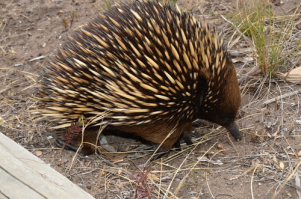By: C.A. Victor
Unlike many of the animals we talk about on the site, you may not have heard about monotremes. Even if you have heard of them, you may not know exactly what they are or if they are even real. We’re here to give you all the information on these unique, fascinating creatures including what they are, where you can find them, and what makes them so special!

What Kind of Animals are Monotremes?
Monotremes are one of the three kinds of mammals: monotremes, marsupials, and placental mammals. Mammals are a type of warm-blooded animal that nourishes their young with milk produced from the mother’s mammary glands. They are one of the five vertebrate classes (animals with a backbone): amphibians, birds, fish, mammals, and reptiles. The mammals are classified under kingdom – Animalia, phylum – Chordata, and class – Mammalia.
What Makes Monotremes Different From Other Mammals?
The biggest difference between monotremes and all other types of mammals is the fact that they do not give birth to live young. Instead, they lay eggs – like reptiles and birds – that hatch outside the mother’s
body. This sets them apart from any other type of mammal, despite their similarities.
The word monotreme comes from the Greek words “mono” (one) and “trema” (hole), which refers to their modes of reproduction. Unlike other mammal types, female monotremes do not have a uterus or a vagina. Instead, they have a cloaca – a single posterior opening for an animal’s digestive, urinary, and reproductive tracts, expelling waste as well as fertilized eggs. The cloaca is most commonly found in birds,
reptiles, amphibians, and most fish.
While they do share many characteristics that put them firmly in the mammal category, monotremes have some unique traits that set them further apart from their other two subgroups. Monotremes have a lower
body temperature than other mammals and a lower metabolic rate. While monotremes do nourish their young with milk, female monotremes do not have nipples. Their young – called “puggles” – feed on mammary glands through openings on the skin. On the other hand, male monotremes have spurs on their ankles. In platypus, these are venomous!
Monotremes have no teeth. They use their unusually hard tongues to press food against the roof of their mouth, crushing it so they can swallow. Given that their diets consist of small insects, this is easier than it sounds. They also have highly distinct jaw anatomy from other mammals regarding the placement of their inner ear openings.
What Animals are Monotremes?
Unlike marsupials or placental mammals, monotreme species are rare in the modern world. There are exactly five surviving species of monotremes on earth! These five species fit into two distinct groups: the echidnas and the platypus.

Platypus.
When most people think of monotremes (if they do!), the first species that comes to mind is the Platypus (Ornithorhynchus anatinus). These semi-aquatic, carnivorous monotremes are native only to eastern Australia (including Tasmania). Also known as the Duck-Billed Platypus, this species resembles an interesting mix of features including a duck-like bill, a tail like a beaver, and feet that more greatly resemble an otter. Their unique appearance and cultural importance (especially among aboriginal peoples) make them popular mascots and an iconic symbol of Australia.
Echidnas.
Echidnas resemble anteaters superficially, though their spines give the impression of a hedgehog or porcupine. In reality, they are more closely related to the platypus than any of those species, being another type of monotreme. They are small, solitary creatures which bodies are covered in thick coarse fur and long spines. They are extremely strong diggers, each limb equipped with long claws. They are also carnivorous, often using those claws to tear apart soft logs and anthills to feast on the insects they discover
within.
There are four living species of echidnas in New Guinea and Southern Australia today:
- Western Long-beaked Echidna (Zaglossus bruijni)
- Eastern Long-beaked Echidna (Zaglossus bartoni)
- Sir David’s Long-beaked Echidna (Zaglossus attenboroughi)
- Short-beaked Echidna (Tachyglossus aculeatus)
Where do Monotremes Live?
Today, monotremes can be found in exactly two places in the world. They are indigenous to the island of New Guinea and Australia.
Fun Monotreme Facts
• Adult monotremes do not have teeth.
• Monotremes have the most in common with marsupials. Some even have pouches for their young!
• While it might seem unlikely, monotremes are carnivorous.
• Echidnas are very common and not considered endangered species. They are protected under Australian law, making it illegal to kill, capture, or keep them as pets.
• The platypus is considered endangered in South Australia and is legally protected as well.
• Adult monotremes only have two native predators: Tasmanian Devils and dingoes. Baby echidnas may be vulnerable to lizards, however.
• As always, humans, introduced animals, and environmental changes are also threats to these species.
